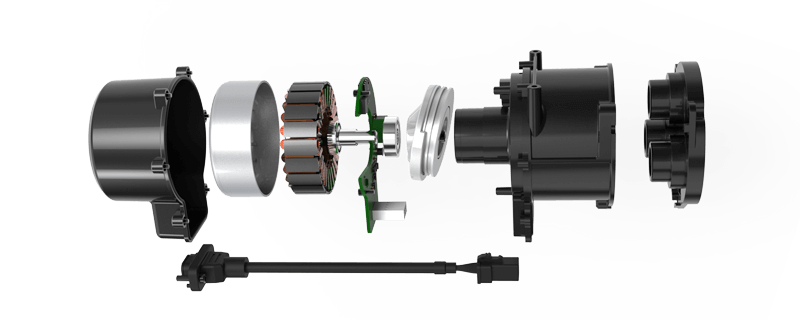part 1:
Unlocking Precision and Power: The Synergy of Ultrasonic Technology and Servo Motors
In the fast-paced universe of automation and robotics, innovation is the cornerstone of progress. Among countless technological advancements, the integration of ultrasonic sensing with servo motors stands out as a game-changer, delivering remarkable precision, control, and adaptability across a diverse array of applications. If you’ve ever been curious about how machines can identify distances, adjust movements with finesse, and operate seamlessly in complex environments, understanding this potent combo might just be the key.

Ultrasonic Technology: A Brief Overview
Ultrasonic sensors operate by emitting high-frequency sound waves—typically above 20 kHz, beyond the range of human hearing—and then measuring the time it takes for the sound waves to bounce back after hitting an object. The speed of sound in air (approximately 343 meters per second) helps the sensor calculate the distance with impressive accuracy, often down to millimeters.
This sensing approach is particularly advantageous because it is non-contact; it can detect objects regardless of their color, transparency, or surface texture. Such traits make ultrasonic sensors invaluable for industrial automation, robotics, level measurement, obstacle detection, and more.
Servo Motors: The Heart of Precise Motion Control
On the other side, servo motors are specialized actuators known for their ability to deliver precise, controllable movement. Unlike simple motors, servo motors integrate a feedback system—usually a potentiometer or an encoder—that continuously monitors the shaft position, providing real-time data to the control system. This feedback allows for highly accurate positioning and speed regulation, making servo motors the ideal choice for applications like robotic arms, CNC machinery, camera control rigs, and miniature vehicles.
The magic happens when you combine ultrasonic sensors with servo motors: sensing capabilities guide the motors’ movements, creating intelligent, adaptive systems bonded by real-time feedback loops. This synergy unlocks a new realm of possibilities, especially where precision and adaptability are non-negotiable.
Industrial Applications: Beyond the Basics
The intersection of ultrasonic sensors and servo motors isn’t just theoretical; it’s a practical powerhouse transforming industries. For example:
Automated sorting and packaging: Ultrasonic sensors identify object dimensions or presence, instructing servo motors to adjust arms or conveyors accordingly. This results in faster, more reliable sorting processes.
Robotic navigation and obstacle avoidance: In autonomous robots, ultrasonic sensors detect obstacles, and servo motors steer the robot’s wheels or arms to navigate without collisions.
Level measurement and fluid control: Ultrasonic sensors monitor liquid levels in tanks, with servo motors controlling valves or pumps to automate the process seamlessly.
Precision manufacturing: Ultrasonic sensors locate components with high accuracy, guiding servo motors to position them exactly where needed, reducing errors and waste.
The appeal lies in the system’s intelligence and responsiveness. Unlike traditional setups that rely on predefined movements, these integrated systems can adapt on the fly, making them ideal for dynamic environments.
Why Ultrasonics and Servos Complement Each Other
The combination offers several distinct advantages:
High precision: Ultrasonic sensors deliver accurate distance measurements. When fed into a servo controller, this data enables exact positioning or manipulation.
Non-contact detection: Ultrasonics can sense objects without physical contact, essential for delicate or hot items, and the servo motors respond accordingly without interference.
Versatility: Whether detecting objects, measuring levels, or guiding movement, the synergy works across myriad use cases.
Cost-effectiveness: Both technologies are mature and affordable, making the combination accessible even for small-scale or custom projects.
Reliability: Ultrasonic sensors are robust against dirt or visual obstructions, ensuring consistent operation outdoors or in harsh environments, complemented by the enduring, repeatable motion of servo motors.
The Challenges and How to Overcome Them
Of course, integrating ultrasonic sensors with servo motors isn’t without hurdles. Signal interference, environmental noise, or reflections can sometimes lead to inaccurate readings. Proper calibration, shielding, and selecting appropriate sensor models are essential.
Similarly, servo motors need to be matched with suitable power supplies and controllers to prevent overheating or mechanical strain. Modern microcontrollers and programmable drives have simplified this process, making sophisticated robotics more accessible than ever.
In conclusion, the fusion of ultrasonic sensing with servo-controlled actuation acts as a catalyst for smarter, more autonomous machines. As industries continue to seek efficiency, accuracy, and flexibility, these technologies will undoubtedly remain at the forefront of innovation—fuelling a new era of intelligent automation.
(Part 1 complete. Do you want me to proceed with the second part? If yes, I will focus on specific case studies, future trends, and deeper technical insights.)
Kpower has delivered professional drive system solutions to over 500 enterprise clients globally with products covering various fields such as Smart Home Systems, Automatic Electronics, Robotics, Precision Agriculture, Drones, and Industrial Automation.




































